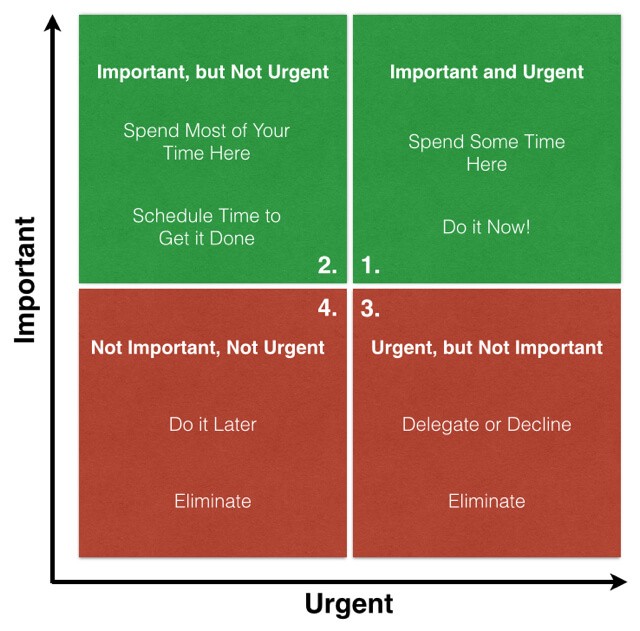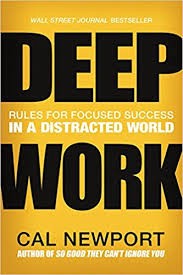
The 4 Ways of Getting More Done By Doing Less
“Start by doing what’s necessary; then do what’s possible; and suddenly you are doing the impossible.”
Francis of Assisi
Earlier this week I sat at a big conference table alongside some really smart people, with many important tasks vying for their attention, and (like all of us) too little time to complete them all.
I’d been summoned to this meeting to train this high functioning group on the not-so-trivial task of getting more done in less time.
It’s the Golden Goose of modern business.
How can we squeeze more productivity out of the limited time and resources available to us?
It’s an interesting question with some interesting answers…
Unfortunately, it’s the absolute wrong question.
As legendary philosopher-emperor Marcus Aurelius so aptly pointed out over two millennia:
“What’s essential: To do less, better.“
And this is where we began our discussion. Not with sneaky tactics, productivity hacks, or fancy apps. But rather with the idea that you mustnever mistake busyness with effectiveness.
The 80/20 Rule (also known as the Pareto Principle) is a fairly well-discussed phenomenon, but simply put, it states that (across all disciplines and areas of life) only about 20% of inputs are responsible for roughly 80% of the outputs.
Put another way, a startlingly few number of activities are responsible for the vast majority of results.
Though many of us are aware of this dictate, an unfortunately high percentage of us fail to apply it effectively to our lives.
Instead, we spin our wheels in hot pursuit of more, more, more. Trying to tackle an ever expanding list of to-dos under the misguided hope that it’ll somehow help.
Spoiler alert: It won’t.
All you’re doing is burning yourself out completing tasks that, if you were to take a step back and answer truthfully, you’d realize aren’t actually helping.
So, operating under the framework that the bulk majority of tasks aren’t worth doing, let’s talk about the 4 ways you can actually check items off your to-do list to get more done.
1) Completion
Do the thing.
This is the traditional way most of us think about checking an item off our to-do list. We actually do the thing.
Problem with completing a task is that very few tasks are really worthcompleting.
When you are creating your daily, weekly, or monthly task list, ask yourself:
Is this a task that I am particularly well suited to complete?
This would be akin to what Cal Newport calls deep work in his aptly named book Deep Work. Deeply challenging, value adding work that only you are capable of completing.
These are the tasks that should consume the bulk-majority of your time, energy, and resources.
Unfortunately, most of us spend too little time working on these types of tasks. Instead, we wallow in shallow work that is simultaneously menial, non-value adding, and entirely outsourceable.
Shallow work should always be checked off the to-do list by way of one of the following three methods.
2) Deletion
Eliminate the task.
The guiding question here should be: Is this really necessary?
If the answer’s no, then delete it. No questions asked.
Many people falsely believe that time is their most valuable resource.
It’s not true.
Attention is your most valuable resource.
Do not squander it on meaningless activities that’re not specifically aiding you in the completion of your goals.
3) Delegation
Assign the task to somebody else.
Okay, so maybe the task is actually important, but not a particularly good use of your time and skill. You can’t just delete it, because it’s something that should get done, but you also shouldn’t play Wonder Woman and take on all tasks yourself.
This is where many corporate manager types go wrong.
They fear delegation makes them appear either lazy or incapable.
Delegation, when done properly, is neither of these things. It’s accepting the fact that people have unique skills, and that any successful team will leverage individual’s strengths and avoid their weaknesses.
Tom Brady is an excellent quarterback, but a substandard lineman.
Figure out what position each person on your team is best equipped to play, and then let them play to their strengths!
How do you know when it’s a task best suited for your assistant?
As a general rule, if somebody can be trained to perform a task 80% as well as you, then do so.
4) Deferment
Put the task off until later.
Tread carefully here, because deferment can look an awful-lot like procrastination.
It’s not that.
It’s the intentional recognition of a task that is neither critical, nor time-dependent. When you discover such a task, consider pushing it off until later or, if it’s truly non-critical, delete it.
A handy way of visualizing tasks is through what’s called the Eisenhower Matrix.
The Eisenhower Matrix
“What is important is seldom urgent, and what is urgent is seldom important.”
Dwight D. Eisenhower

In the Eisenhower Matrix tasks can be subdivided into one of four categories as judged in terms of Importance and Urgency.
In Quadrant 1 you have tasks that are simultaneously Important and Urgent.
It goes without saying that these tasks should always be done first. Thankfully, due to their Urgent nature, we don’t typically have to be told twice to get these tasks done.
Things start falling apart when we arrive at Quadrant 2. These are tasks that are Important, but Not Urgent.
These tasks almost inevitably get procrastinated. Which is a recipe for disaster.
Tasks in Quadrant 2 must get scheduled, otherwise they will always get pushed aside in favor of tasks of more Urgency.
Tasks such as the ones that comprise Quadrant 3.
These activities are Urgent, but Not Important. Too often we prioritize this quadrant with the false belief we are being effective, when in reality we are merely busy.
Complete these tasks, but only after you’ve dedicated the bulk majority of your time and energy towards the completion of activities in Quadrant 1 and 2.
Quadrant 4 is reserved for a special type of meaningless work that is neither Important nor Urgent.
When faced with work of this sort, one must ask themselves: Why bother?
Delegate, Defer, or Delete these tasks and don’t waste one precious second feeling bad about it.
Your initial reaction might be to protest the existence of Quadrant 4 activities in your work-day, but a little critical analysis will inevitably prove the opposite to be true.
There are more Quadrant 4 activities on your to-do list than you probably want to admit.
Root them out, but most importantly, discover your Quadrant 1 and Quadrant 2 tasks.
Once you’ve separated the Important from the Non-Important tasks, apply one of the four modes of accomplishing a task we’ve discussed (completion, deletion, delegation, deferment) to tackle your to-do list with the knowledge that you are, without a doubt, being effective.
Execute on this game plan and you’ll soon become a master of Doing less, better.

